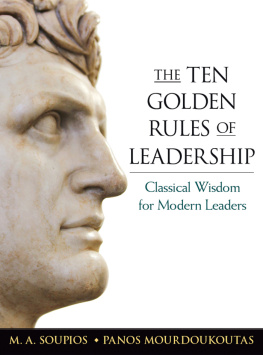Barakaldo Books 2020, all rights reserved. No part of this publication may be reproduced, stored in a retrieval system or transmitted by any means, electrical, mechanical or otherwise without the written permission of the copyright holder.
Publishers Note
Although in most cases we have retained the Authors original spelling and grammar to authentically reproduce the work of the Author and the original intent of such material, some additional notes and clarifications have been added for the modern readers benefit.
We have also made every effort to include all maps and illustrations of the original edition the limitations of formatting do not allow of including larger maps, we will upload as many of these maps as possible.
RULES FOR LEADERSHIP
IMPROVING UNIT PERFORMANCE
BY
JON W. BLADES
TABLE OF CONTENTS
Contents
TABLE OF CONTENTS
REQUEST FROM THE PUBLISHER
DEDICATION
DUTY * HONOR * COUNTRY
This book is dedicated to leaders of all ranks who aspire to these values
J.W.B.
Rules
1. The Relationship Between Nondirective Leadership and Group Performance
2. The Relationship Between Directive Leadership and Group Performance
3. The Relationship Between Leader Enforcement of Performance Standards and Group Performance
4. The Relationship Between Member Intelligence and Group Performance
5. The Relationship Between Member Ability and Group Performance
6. The Relationship Between Leader Intelligence and Group Performance
7. The Relationship Between Leader Ability and Group Performance
8. The Relationship Between Member Motivation and Group Performance
9. The Relationship Between Leader Motivation and Group Performance
10. The Relationship Between Group Cohesion and Group Performance
Tables and Figures
Tables
1. Comparison Between the Performance Scores of Nondirective-Led Groups
2. Comparison Between the Performance Scores of Directive-Led Groups
3. Correlations Between Leader Enforcement of Performance Standards and Group Performance
4. Correlations Between Member Intelligence and Group Performance
5. Correlations Between Member Ability and Group Performance
6. Correlations Between Leader Intelligence and Group Performance
7. Correlations Between Leader Ability and Group Performance
8. Correlations Between Member Motivation and Group Performance
9. Correlations Between Leader Motivation and Group Performance
10. Correlations Between Group Cohesion and Group Performance
Figures
1. How Differences in Leadership Style Affect the Influence of Member and Leader Ability on Performance
2. Rules for Leadership
Foreword
What is successful leadership and why are some leaders more successful than others? Searching for the answer, Lieutenant-Colonel Jon Blades, US Armyan experienced troop commander and scholar of leadership theoryhas studied the performance of Army leaders and units for most of his career. This book reflects both his experience and extensive research.
Literature on the subject of leadership contains divergent conclusions about how style, intelligence, ability, motivation, cohesion, and standards affect unit performance. Colonel Blades confirms the value of each of these elements and then explains the relationships among them. Most important, he presents practical rules leaders might apply in varying situations to improve the mission performance of their units.
It is appropriate that Colonel Blades wrote his findings during 1985, the Armys Year of Leadership. The National Defense University is pleased to publish this contribution to the art of leadership .
Richard D. Lawrence
Lieutenant-General, US Army
President, National Defense University
Preface
This book presents an original set of leadership rules or principles that can be used to improve unit performance in any specific group situation and at all organizational levels. The 10 rules describe the influence which leadership style, leader enforcement of performance standards, group member intelligence, group member ability, leader intelligence, leader ability, group member motivation, leader motivation, and group cohesion have on unit performance.
Basically, the evidence establishes very clearly that (1) the nondirective and directive leadership styles are each very effective ways to improve unit performance in certain situations but are poor choices to use in others; (2) high levels of enforcement of performance standards, intelligence, ability, motivation, and cohesion will increase unit performance in some situations but will not influence the outcome in others; and (3) low levels of these factors will decrease unit performance in certain situations but will not affect the outcome in others. In other words, the effect each of these factors has on performance is not constant but, rather, varies from one situation to the next. The key premise is that the amount of influence each of these factors has on performance depends upon the presence or absence of certain other factors in the group situation. For each rule in this book, statistical evidence in the form of data collected from 49 US Army units is presented in support. The summary chapter integrates the separate rules and presents recommended courses of action for the leader to take in order to use the rules properly in whatever particular group situation is encountered.
In a secondary role, additional material is presented which describes actions that leaders can take to raise the level of several important group qualities such as motivation, ability, and cohesion.
Acknowledgments
I wish to gratefully recognize Emile Chum Robert, Walter Ulmer, and Albert Akers for very generously providing assistance to me in writing this book. Their reviews of the draft manuscript, contributions, and comments were especially valuable.
Other friends and professional associates also assisted with suggestions and were very encouraging with their comments. John Johns, Norm Grunstad, Bob Haffa, and Steve Blades deserve special acknowledgment. Further, Kent Esbenshades extensive editorial contribution is worthy of special mention.
Several individuals within the National Defense University Research and Publications Directorate should also be recognized for their assistance. I appreciate the work of Fred Kiley, Jan Hietala, and Pat Williams.
J.W.B.
Introduction by Walter F. Ulmer, Jr.
There appears to be within America a resurgence of interest in the study and application of leadership. Stung by the success of foreign companies in the US marketplace, aware that up-to-date technology is essential but yet not the tonic that ensures excellent corporate results, and excited by stories of organizational success stemming from executive vision and competence, Americans in many sectors have rediscovered the importance of leadership. While the militarys enthusiasm for the subject has never really waned, its approach to leadership has wandered, been diffused and refocused, exuded confidence in or scorn for useful behavioral models, and debated the born versus learned theses.
















